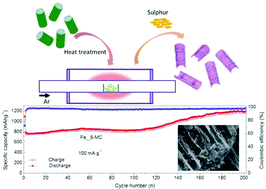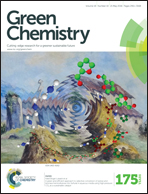Fe1−xS/C nanocomposites from sugarcane waste-derived microporous carbon for high-performance lithium ion batteries†
Abstract
We report a novel strategy to collect microporous carbon from disposable sugarcane waste for lithium ion battery (LIB) applications. First boiled in water and ethanol and then calcined, the sugarcane waste successfully transforms into microporous carbon, delivering a specific capacity of 311 mA h g−1 at 0.33C as a LIB anode material. For improved LIB performance, pyrrhotite-5T Fe1−xS nanoparticles were uniformly dispersed and robustly attached to the scaffold of the microporous carbon using a novel sulfurization method. A remarkably ultrahigh capacity of 1185 mA h g−1 (well beyond the theoretical value by 576 mA h g−1) was achieved after 200 charging/discharging cycles at a current density of 100 mA g−1, suggesting desirable synergetic effects between Fe1−xS and microporous carbon which lead to a shortened lithium ion transportation path, enhanced conductivity and effective prevention of polysulfide dissolution. Our approach opens a convenient route for mass-producing sustainable, superior LIB electrodes from natural wastes that can substitute commercial graphite.


 Please wait while we load your content...
Please wait while we load your content...